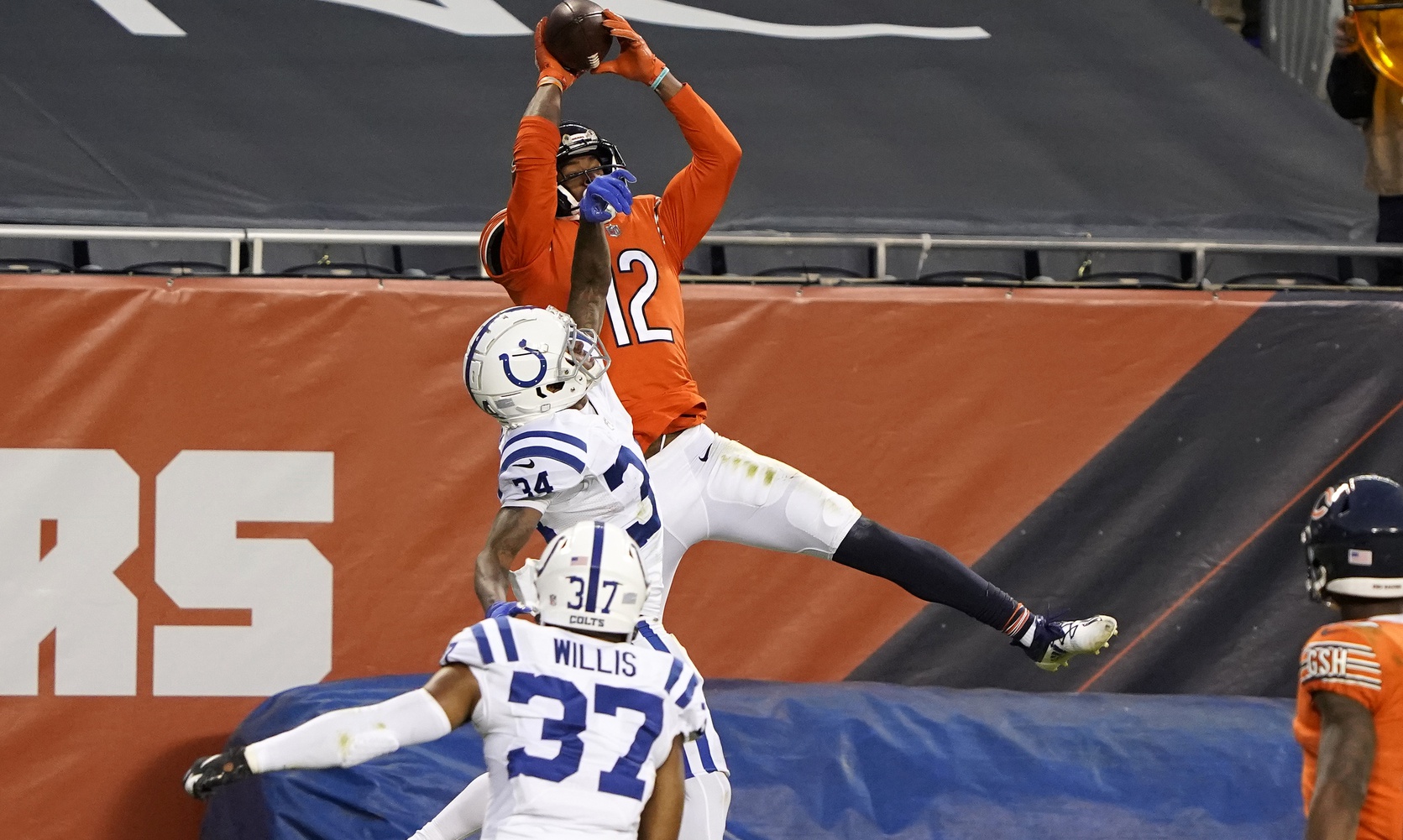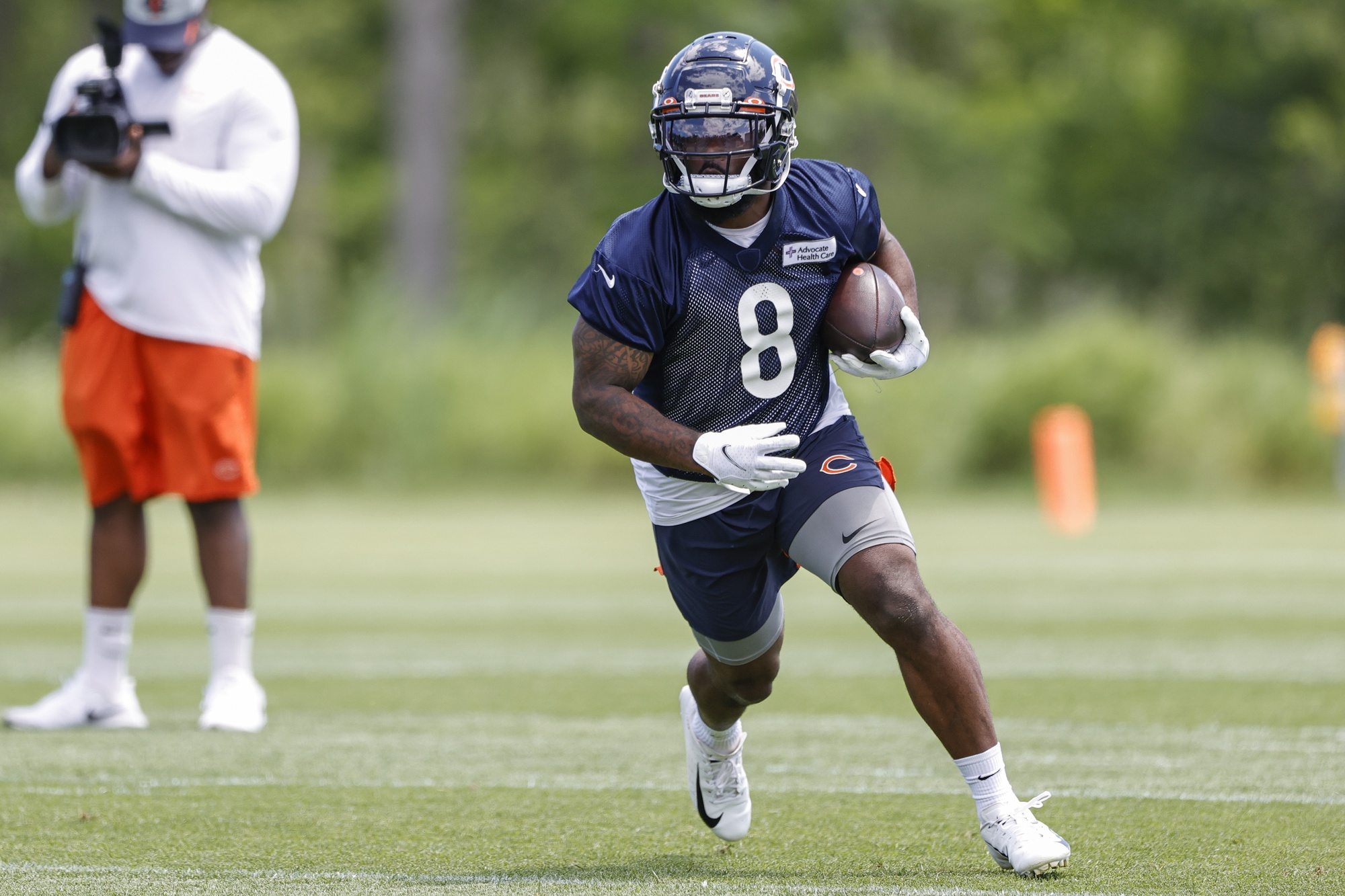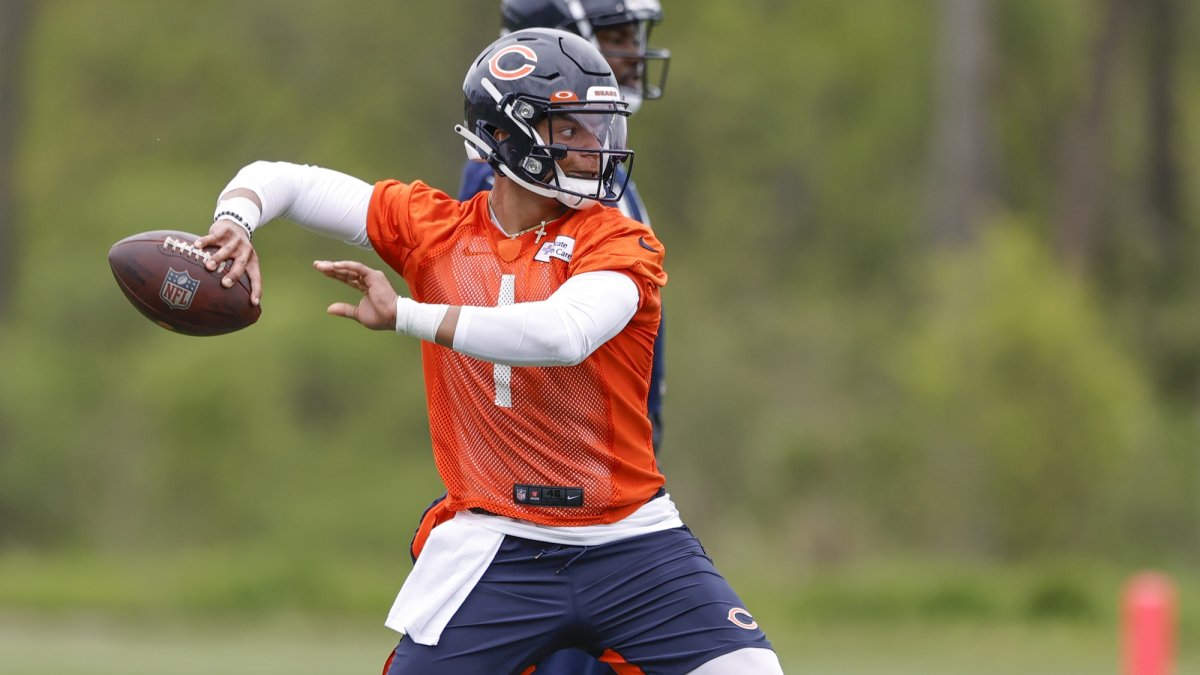The Mitchell Trubisky era is officially over in the Windy City. The Chicago Bears wisely decided they had seen enough of the former No. 2 overall pick after four straight years of sub-67.0 PFF grades, headlined by an atrocious 2020 season that saw Trubisky finish 36th in PFF passing grade (58.8).
Let the Justin Fields era begin.
As part of their quarterback transition, the Bears traded up from pick No. 20 to No. 11 in the 2021 NFL Draft to select their quarterback of the future in Fields. The team also brought in veteran Andy Dalton to serve as a bridge, but it’s only a matter of time before the rookie gets his feet wet in the NFL.
More of PFF's 2021 Fantasy Football tools here:
Fantasy Football Draft Kit | Rankings & Tiers | Draft Guide | Cheat Sheets
Projections | Strength of Schedule | Expected Points | Weekly Finishes
Subscribe to
2021 Team Preview
Dalton is slated to be the team’s starting quarterback to open the season, but that’s not as detrimental to the Bears’ fantasy stars as one might initially think.
He is by no means a quarterback who will elevate those around him, but he was better than the Trubisky/Nick Foles duo the Bears strutted out last season. Dalton was PFF’s 24th-graded quarterback last season, and he ended the year (Weeks 11-17) strong as PFF’s 17th-graded quarterback.
2020 – Andy Dalton 69.6 (24th)
WE HAVE REACHED NEW HEIGHTS https://t.co/TTVXwzdsIx
— Andrew Erickson™ (@AndrewErickson_) March 16, 2021
Over that span, he ranked sixth in passing attempts, 16th in expected fantasy points per game and second in expected passing touchdowns. The Red Rifle has enough bullets in the chamber to help the Bears avoid being a bottom-dwelling offense, especially because his high passing volume will continue in Chicago.
The Bears threw at the fifth-highest rate on early downs (62%) during Matt Nagy’s stretch as the team’s play caller. With Nagy returning to play-calling duties in 2021, there should be a plethora of targets to feed more than one Bears’ pass catcher.
Poor offensive line play remains the largest concern and could deter the passing game. Chicago will field PFF’s 28th-ranked offensive line heading into the season, and that’s assuming second-round tackle Teven Jenkins is healthy. He’s currently dealing with a back injury.
Dalton’s lack of mobility and off-script playmaking could make life really difficult for him behind a patchwork offensive line. The Nagy and Ryan Pace head coach/general manager combination cannot afford to lose games, as both are firmly on the hot seat.
So, even though Nagy is firmly behind his stance that Dalton is the starter over Fields, circumstances may force him to start the rookie in an effort to save his job.
The offense will likely skew more toward the run game with Fields under center. Last year with a mobile Trubisky at the helm, the Bears’ pass-play rate on early downs fell to 20th (55%). With Foles — who profiles closer to Dalton — Chicago’s pass-play rate on early downs ranked second (65%).
Fields’ rushing upside — he averaged eight rushing attempts and nearly 55 rushing yards per game at Ohio State — makes the switch to a run-heavy approach logical. It’s also one of the reasons Fields is such an excellent late-round quarterback option (ADP QB16), as his legs offer fantasy value over his statuesque quarterback counterpart.
Fields is also a hyper-accurate passer — 72.4% accurate-pass rate, No. 1 in college football — which just further cements him as the late-round quarterback.
Remember, lesser quarterbacks have functioned as fantasy options under the Nagy regime. In his second season, Trubisky finished seventh in fantasy points per dropback (0.55) and 12th in fantasy points per game (19.5). If Trubisky can be a top-15 fantasy quarterback in his first season under Nagy, we should be confident that Fields can do the same.
Fields’ proficiency as a passer also means Allen Robinson II has a chance to set career efficiency marks across the board.
VALUES
WR Allen Robinson II

Only 64.0% of Robinson's targets have been deemed “catchable” since he entered the NFL — that ranks 93rd out of 101 qualifiers.
It’s a breath of fresh air for drafters investing in Robinson with a mid-third-round pick (ADP WR12), knowing he’s going to eventually catch passes from the best quarterback (Fields) he’s ever played with. The volume has been there — he's the only player to command 150-plus targets in each of the past two seasons — and Robinson finished fifth (14.0) and eighth (13.8) among receivers in expected fantasy points per game over the same time frame. Any improvement in quarterback play could send his fantasy ceiling through the roof.
Fields' proficiency near the goal line bodes well for Robinson, as the Ohio State alumnus ranked fifth in passing touchdowns on end-zone throws in 2020. The Bears’ No. 1 wideout earned a 35% end-zone target share last season (10th) but hauled in only 31% (21st) of his targets.
The 2020 Bears quarterbacks combined for an egregious 48.6 passer rating when targeting the end zone last season, the fourth-worst mark in the league.
Having Fields under center is the ideal outcome for Robinson, but Dalton doesn’t entirely tank his fantasy value. He still should see plenty of volume in a pass-heavy offense, and Dalton’s one saving grace was his PFF passing grade at the intermediate level in 2020.
From 10-19 yards, Dalton posted a 90.7 PFF passing grade — eighth at the position — from Week 11 onward. His grade was higher than Dak Prescott’s on the same type of throws.
Dalton can keep Robinson locked into the low-end WR1 territory until the inevitable quarterback change. Last season, Robinson was fourth in targets (43) and finished as PFF’s fourth-highest-graded receiver on 10-19 yard throws.
RB David Montgomery
Montgomery finished the year with 301 touches (20 per game), which ranked fourth among all running backs. Tarik Cohen’s injury certainly helped vault Montgomery to RB1 status, especially down the stretch — he was fantasy RB1 overall from Week 12 on — but Montgomery would have likely flirted with 250 total touches either way.
Fantasy drafters simply can’t ignore young running backs with guaranteed volume, even if they aren't exciting names or athletic freaks. Much of the talk out of Bears’ camp is about how the team wants to get Montgomery 20 carries per game, and that volume provides the rationale to be “in” on him at his current cost (fourth or fifth round, RB18 ADP).
Although Montgomery is often the punch-line for “unathletic RBs,” his elusiveness is vastly underrated. His broken tackle rate improved drastically in his second season, and he racked up over 100 more rushing yards on carries of 15-plus yards compared to 2019.

Heading into the 2020 season, Montgomery’s ADP hovered around low-end RB2 territory. He was a value then, and he's currently being drafted in a similar range, meaning his price is already factoring in the potential loss of pass-game work — whether that be due to the potential of a mobile quarterback under center or another running back (Cohen/Damien Williams) eating into his receiving snaps.
Montgomery could still see plenty of work as a receiver in games with Dalton, as the ex-Cowboys quarterback can’t run and ranked fifth in targets to running backs during his last seven games in Dallas.
When Fields takes over, Montgomery will likely see a bump in rushing efficiency due to the “open lanes” corollary, which should help mitigate some loss in fantasy production from fewer receptions. The offense could also just be better overall, which presents more scoring opportunities for Montgomery.
Montgomery is a solid and safe RB2 who offers top-five upside when everything works in his favor. Even when he’s not facing easy matchups or isn't the primary pass-catching option (Weeks 1-11 of last season), Montgomery was still the RB27 in points per game and the RB12 in expected fantasy points per game.
Like it or not, the volume is going to be there in the end, which ultimately will make him a steady and reliable fantasy option.
BREAKOUTS
WR Darnell Mooney
Only two rookie wide receivers caught at least two passes in every game during the 2020 regular season: Justin Jefferson and Mooney. The fifth-rounder out of Tulane shocked the fantasy football world when he ascended to the No. 2 wide receiver position on the Chicago depth chart.
Mooney commanded 94 targets and caught 61 passes, which ranked sixth and fifth, respectively, among rookie wide receivers. He also saw at least six targets in half of his games and led all rookies with 17 forced missed tackles.
His rookie campaign compares best statistically to the likes of Michael Gallup and Will Fuller V, who both made significant strides in their second NFL seasons.
Fuller, Gallup and Mooney Rookie Seasons
| Player | Targets | Receptions | Yards | YPRR | PFF Grade | aDOT |
| Will Fuller V | 112 | 62 | 832 | 1.30 | 64.9 | 15.5 |
| Michael Gallup | 96 | 48 | 719 | 1.30 | 62.9 | 14.1 |
| Darnell Mooney | 94 | 61 | 631 | 1.20 | 67.3 | 12.1 |
Mooney flashed as a deep threat in 2020, commanding an almost identical percentage of 20-plus-yard throws as Robinson (30% versus 29%). The second-year receiver will benefit from the eventual transition to Fields, who isn’t afraid to attack downfield.
Fields ranks second in passing touchdowns of 20-plus yards (29) and third in air yards percentage (71.2%) since the start of the 2019 college football season. The quarterback upgrade from 2020 can’t be overstated enough.
Mooney wasn’t particularly efficient as a rookie — his 1.20 yards per route run ranked 13th out of 14 qualifying rookie receivers. The erratic quarterback situation was the main culprit, though. Mooney got open constantly, but the deep passes were hardly ever on the mark. His catchable deep-ball rate (32%) ranked seventh-worst among receivers with at least 20 deep targets.
The Mooney breakout comes with a caveat, as it might not happen until Fields takes over at starting quarterback. Dalton’s uninspiring deep-ball rate (10.2%, 28th) and deep-ball passing grade (70.2, 29th) will make it tougher for Mooney to come out of the gate blazing.
BUSTS
RB Tarik Cohen
Before more uninspiring news surfaced about Cohen’s injury, he looked like a nice late-round bargain in PPR formats. And prior to his injury-lost 2020 campaign, the Bears' scatback was coming off back-to-back seasons with at least 74 receptions. He’s one of only seven running backs to have at least 150 receptions since 2018.
It’s impossible to have any confidence in drafting him, however, as he is still weeks away from returning to the field.
Besides, his 2019 campaign saw him post career-lows in yards per route run, PFF receiving grade, PFF rushing grade and elusive rating. A return to his 2017-2018 form when he was an uber-productive third-down back might just not be in his range of outcomes anymore.
SLEEPERS
RB Damien Williams

A 2020 opt-out, Williams has impressed at Bears camp as a receiver. It remains to be seen how much of Montgomery’s 63 targets from a season ago Williams will siphon, but it’s noteworthy because a pass-catching role would make him a super intriguing option in the late double-digit rounds.
Williams caught at least three passes in over half of his games for the Kansas City Chiefs in 2019.
If Cohen’s injury extends into the regular season, Williams could emerge as a dark-horse candidate to fill in at the slot position. Cohen played over 27% of his snaps from the slot in 2019, and the team’s leading slot receiver from 2020 Anthony Miller (77% slot snap share) was recently traded to the Houston Texans.
Additionally, Williams could potentially flirt with a three-down workload if anything were to happen to Montgomery.
TE Cole Kmet
The second-year tight end looks to build off a rookie season where his role began to take shape as the year progressed.
After the team’s bye week, Kmet never saw less than 77% of the team’s offensive snaps and played ahead of veteran Jimmy Graham. Kmet was unable to convert his 159 routes run (11th-most at the position) into any worthwhile production, but the uptick in usage is encouraging for a talented player entering Year 2.
Just be wary: As long as Graham remains on the roster, he will remain a candidate to earn targets in the red zone that would otherwise be for Kmet.



 © 2024 PFF - all rights reserved.
© 2024 PFF - all rights reserved.